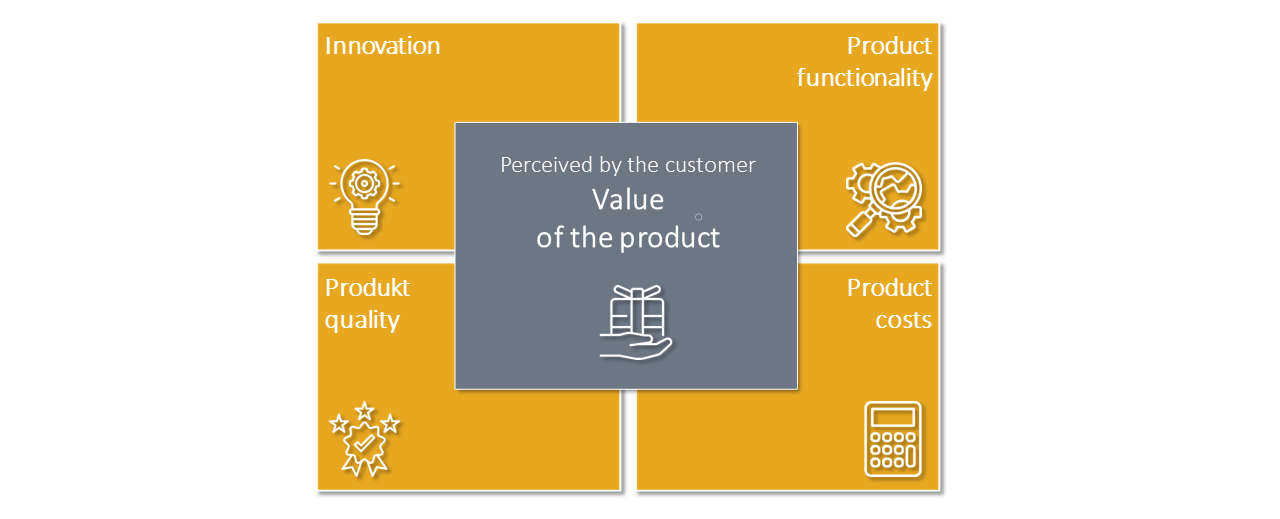Drivers of performance improvement
High-performance product development is a battle fought on many fronts. The classic drivers remain valid, but management has become infinitely more complex. Fast-moving markets keep product requirements in a state of flux until shortly before series production is ready – and sometimes even afterwards. New methods – such as digitalisation and agile working – open up a much broader spectrum of required processes for efficient work organisation. Therefore, the challenge of finding the right working point in the so-called magic triangle is growing for companies. Products that the customer values must be developed. In tandem, the use of resources should be minimal and the time-to-market must be aligned with both the customer and target markets.

Increasing product value
Products should offer exactly what the customer expects and is willing to pay for. By now, every company knows that these customer requirements can only be determined in a highly integrated and interdisciplinary process and that solutions can only be developed in a targeted manner. This process works in both directions. On the one hand, outside-in, where existing customer requirements and expectations must be analysed and evaluated in relation to the future portfolio. On the other hand, inside-out, by evaluating innovative ideas that are not yet known to the customer and, therefore, are not subject to any expectations. Of course, the performance of sales and marketing must also be included in the evaluation, in view of the fact that customer demand for innovative product features often has to be stimulated for the first time before there is a willingness to buy. Not every sales organisation succeeds in generating higher revenues for particularly innovative features.
The basis for this is a well-structured innovation process. In addition, carefully selected functional features are an important driver for market success. These features must be translated into a product quality that the customer values. The discourse on whether products can also have a level of quality deemed too high is probably familiar to many companies. Ultimately, product costs must be competitive. These four success factors must be constantly adjusted and aligned in rapidly changing markets. Key processes for this are the definition of product and technology strategy, as well as portfolio and requirements management. These processes encapsulate clear characteristics in both agile and traditional environments.
Increase efficiency
In addition to the question of WHAT is developed, the HOW represents a decisive challenge for the development manager. The goal is to realise the desired product with the least possible use of resources. Often, this translates into only allowing R&D costs to increase at a lower rate than turnover, i.e. lowering the R&D quota. On the one hand, it is a matter of improving interdisciplinary cooperation, avoiding waste and delivering work results right-first-time. The core is an efficient, interdisciplinary product development process (PEP). In order to manage this process properly, robust project management is required. Agile working methods offer additional sources of leverage. On the other hand, a differentiated approach to platform- and module development helps you to entirely avoid the recurring costs associated with multiple development efforts. A well-balanced global development network can lend additional support to you in generating services in “best cost countries” at lower costs with the same quality.
Due to the fact that the success factors of efficient HOWs – like product requirements – are subject to fast-moving change, it is also important for the strategically minded and acting development manager to keep an eye on strategic flexibility, as well as on the operational flexibility and efficiency of the organisation.
Only those who continuously develop in this area are able to ensure competitive efficiency, even in the face of disruptive changes – the Coronavirus pandemic being one good example.
Shortening time-to-market
Naturally, time-to-market (T2M) can also be seen as a component of efficiency. But we make a conscious differentiation here.
On the one hand, this is because there, in part, other drivers for optimisation. In addition to the product development process, good portfolio management is also important for short development times. Furthermore, technology and advance development, as well as the platform and module development already mentioned under “Increasing efficiency”, must be neatly integrated into the product development process.
On the other hand, there are also different optimisation criteria depending on the development project at hand. For example, all suppliers to an automotive manufacturer are usually tied to the overall development of the vehicle with their components. With this in mind, they cannot directly use a shorter T2M to generate sales earlier. However, such companies also benefit from short development times because they gain time for the elaboration and optimisation of variants, which are helpful in the proactive management of the customer. In this respect, it is, as a general rule, always prudent to aim for a short development time. Whether the result can then be used for an earlier market launch or has a competence-enhancing effect as a supplier, must be differentiated on a case-by-case basis.
In the meantime, practice has shown that agile working methods – such as Scrum – can also significantly shorten T2M.
The benefit to you
- You will enjoy greater success in the market.
- You will have reliable schedules.
- You will utilise a smaller amount of resources.
- You will get control of your processes.


